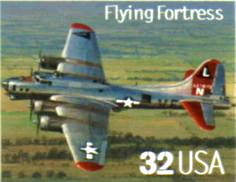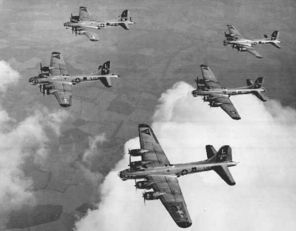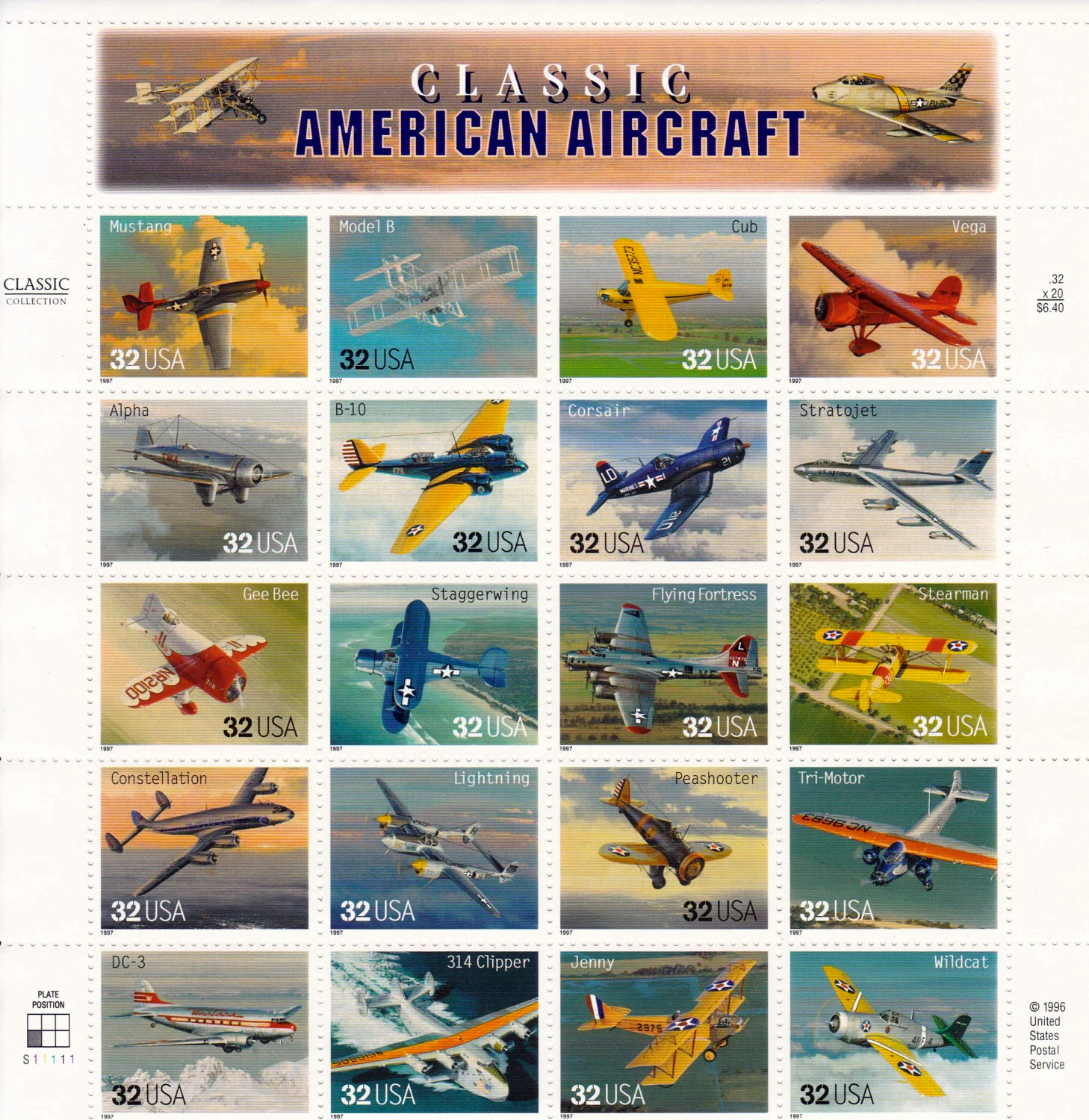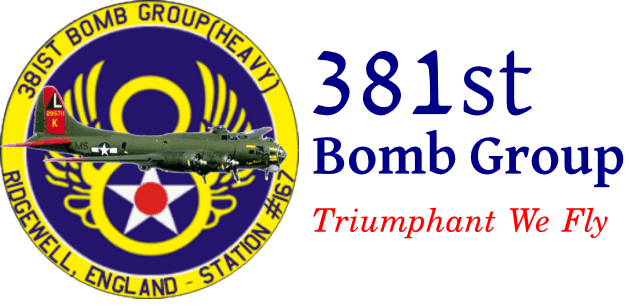
The US Postal Service has issued a 1997 series of stamps depicting twenty different “classic aircraft”. Bill Phillips, an aviation artist from Ashland, Oregon, is said to have worked for two years doing the paintings for the stamps from historic photos.
One of these is of a B-17G, the Flying Fortress of World War II fame. The picture used for the B-17 stamp was taken in England on August 5, 1944, by a photographer from Life Magazine, and the formation in which the plane was flying was led by Lloyd E. Sunderland, a native of Wayne Township in Mifflin County, PA. He was assigned to the 532nd Squadron of the 381st Bomb Group stationed at Ridgewell Air Base in England.
The B-17 Stamp picture is one of many taken by the Life photographer that day. His pictures were rather special because they were on color film and made under the most favorable conditions — not on a combat mission. Although this one is obviously not in color, it shows a similar profile.
On August 5, 1944, the 381st Bomb Group flew on a mission to Nienburg, Germany, but some of the crews “stood down” based on the system of rotation for the flyers. Training requirements had to be met on these “off” days, and Sunderland was assigned to lead a squadron of six planes for formation practice.

The photographer had made arrangements to be flown in the Group’s older B-17E (a/c# 41-9043, “Peggy D”, and later “Little Rockette”) which was stripped of all armament and used for transport, and he could be seen taking pictures from the wide open waist windows with his big camera (probably a Speed Graphic) where fifty-caliber machine guns had been mounted during combat missions.Also, the 355th Fighter Group was invited to send a P-51 to fly with the formation as if providing fighter escort in combat. They sent one of their most renowned fighter planes (named “The Iowa Beaut” by Robert Hulderman for an Iowa lass) which had been credited with at least ten air victories but was lost soon thereafter on 11 September, 1944.
Combat formations were normally flown at that time with three squadrons of six ships each: one lead, one low on the left, and one high on the right. Most of the pictures taken on that training mission were of the conventional six-ship box consisting of two elements of three ships each. But the photographer asked for a six-ship echelon formation, so that unusual stack up was flown for a while.
A picture of that echelon formation appeared in the July, 1945, issue of “Flying” magazine. Over the past fifty odd years, pictures taken of the six B-17’s and the P-51 have appeared in many publications, brochures and other government or commercial uses. The photographer mailed several large black and white prints of pictures taken on that mission to Sunderland, and they are still held as prized souvenirs.
The main distinguishing feature of these B-17’s is the 381st Triangle-L on the tail. The “Triangle” representing the First Division of the Eighth Air Force, and the “L” representing the 381st Group. The “VE” on the fuselage represented the 532nd Squadron, “VP” was for the 533rd, “GD” for the 534th, and “MS” for the 535th.The 381st Bomb Group held its annual reunion in Baltimore from September 2 to 9, 1997.
The pilot who flew the B-17 pictured on the US Stamp when the picture was taken was there. He is Everett E Worrell, Jr., of Disputanta, VA. He flew on the right wing of the lead ship in aircraft # 43-37675 with “N” on its tail. Worrell’s log shows that the plane was named “Patches” at the time, however; records show that it had three different names during its active duty tour (“Flak Magnet”, “Patches” and “Trudie’s Terror”). The lead ship in the formation (#42-107112) was named “Sleepy Time Gal” after one of Varga’s famous paintings which adorned its nose.
On August 27, 1944, crews of the 381st Bomb Group were briefed to fly a mission to Berlin. Sunderland was leading a squadron, and Warren Davis of the 532nd Squadron was flying as an element leader in “Flak Magnet” according to the log of Frank K Kleinwechter of Davis’s crew. Frank, who now lives in Fort Worth, TX, has provided the following narrative: “We had been briefed for a mission to Berlin, and I believe it was a max effort with a thousand or more planes. About half way there, Eighth AF Hq called off the sortie because of very bad weather in the target area, but they did authorize the individual Group leaders to pick a target of opportunity and drop the bombs rather than bring them back to England.
We (Davis’s crew) were flying as an element lead and I was working as a navigator. The leader announced that an alternate target would be selected by his team, but he did not designate it over the radio. He told the group that the navigators would probably be able to identify it as we continued on the run. Emden is not very far inland from the North Sea. The bomb run did not seem very bad until about time for bomb release when the flak really started to hit. Right at “bomb’s away” John Dufek, the top turret gunner (flight engineer) stepped down from his turret to check whether all the bombs had cleared prior to closing the doors. Just as he did a shell burst off our right wing, I believe. A couple of pieces entered his back. The ship on our right wing suffered considerable damage, but I am not sure what crew was flying in it. Flak Magnet/Patches had many flak holes. I don’t recall any heavier damage to our ship on any of my other 34 missions.
I believe it was Gayle Bromander (copilot) who got to Dufek first. Then, between the two of us, we got him down into the nose where we started to administer first aid. We cut open his heavy flying suit to get to the wounds and to give him a shot of morphine. I had taken a copy of Stars and Stripes along to read in my spare time, and it ended up on the floor very close to Dufek’s face where it remained all the way back to England. I didn’t realize that there was a picture of Adolf Hitler on the front page, right in front of John’s face, until they started to drag him out of the nose section. He reached out feebly and crunched that paper with the remark “You S.O.B.”. I won’t ever forget that.
In Chaplain Brown’s book, he states only that all aircraft returned safely. He does not have any remarks about damage or injuries. I am sure that the ship on our right wing had severe injuries. I just talked to Paul Hege, for the first time in fifty three years, and he does not recall anything more about that mission than I sent you earlier. He was in the nose with me as the toggler, and he said that he was given an extra cluster to his Air Medal for the first aid he gave to Dufek. Primarily, what he remembers is that it was a long rough flight. Hege now lives in Palatka, Florida. On that same mission Raymond LaPierre was flying “Mizpah” (a/c # 42-31575) in the squadron Sunderland was leading and most likely on the wing of Warren Davis in Flak Magnet/Patches. Robert Armstrong was flying as LaPierre’s copilot. He has written a detailed account of the personal injuries and aircraft damage in his new but unpublished book, Friendly and Enemy Skies. A close burst of flak sent a piece of shrapnel over Armstrong’s head, hitting the ADF radio compass control box and driving it’s handle into pilot Lapierre’s neck, paralyzing him. He fell onto the flight controls causing an abrupt dive while the wounded flight engineer/top turret gunner, Keith Jensen, fell to the floor behind the pilot, momentarily unconscious. Later, it was determined that William Combs, waist gunner, had received serious injuries to face and eyes from glass shattered by shrapnel. The plane had lost rudder controls, oxygen system and hydraulic system among many other flak damages. Armstrong faced a real challenge to get control of the aircraft and fly it back to England. He reports that he and Ernest White, navigator, counted 341 holes in Mizpah when she went into the hangar for repairs. It was Mizpah’s 80th mission.
On October 14th, 1944, George Schackley led a combat wing comprised of 381st Bomb Group planes and crews on a bombing mission to Cologne, Germany, and Sunderland was leading the high box in the lead group formation with Worrell flying on his right wing and Robert W. Devenish of Sun Prairie, WI, on his left wing. Devenish had to leave the formation over France, and Charles W. Reseigh of Long Beach, CA, moved up from the tail-end Charlie position to replace him. On the bomb run over Cologne, Resigh’s plane had the cockpit canopy blown off, and he was severely wounded. His copilot and flight engineer miraculously flew the plane back to Debach, England, (home of the 493rd Bomb Group) with two engines out on one side. The plane, named “Pella Tulip” (for a town in Iowa), reportedly had over 200 flak holes in it in addition to extensive cockpit and engine damage so it was salvaged for parts. On the same bomb run, Worrell was flying “Patches” again, and it sustained some 300 holes from flak damage without a single person being injured.
Bob Armstrong was assigned as first pilot with LaPierre’s crew beginning on November 3, and would you believe that his plane was Patches/Flak Magnet — just returned to service after the October 14th battle damage. The mission on November 3rd was scrubbed, but Bob was assigned the same plane again on the 4th for a mission to Hamburg. His book has a taxi diagram showing that he was to follow his old friend Mizpah (piloted by Smith) into takeoff position. In early morning darkness with a heavy load of fuel and twelve 500# bombs, Armstrong started his first combat mission takeoff as pilot on Ridgewell’s shortest runway with a crosswind Apparently the only damage done was several runway lights knocked off by 43-37675’s tail wheel. Armstrong decided to follow Defense Department policy (Don’t ask, don’t tell), and he had no repercussions from the incident. His detailed personal account in his book is most interesting. He now lives in Hutchinson, KS.
Robert E Peyton of Everett, Washington, reports that he flew the “new” plane from the repair depot in England back to Ridgewell Air Base in January, 1945. He says that, although it was a 1943 production bird, it was outfitted with all the latest features of a new airplane. He and his crew agreed to name the “new” plane “Trudie’s Terror” after his wife. Peyton flew 25 missions before the end of WWII and then flew “Patches/Trudie’s Terror” back to the States and left it at Bradley Air Base in Connecticut on May 27 1945. Eventually it was taken to Kingman, AZ, where it was retired along with many other weary war birds. Peyton had a small cap from the steering column with his name in it returned to him by a mechanic who was dismantling the plane in 1962.That B-17 certainly earned its exalted place on the face of a United States Postage Stamp.
At the reunion in Baltimore, Sunderland and his daughter, Dr. Gayle (Sunderland) Post, met with three of his crew members and the widow of another who had flown 35 missions with him. His navigator, Art Sherman, another Central Pennsylvania native, and his wife Priscilla hosted the reunion with about three hundred attending. And, after fifty three years, they met with pilots Devenish and Reseigh as well as Worrell and his copilot, Alex Strohmayer, of White Plains, NY; and, a phone call was made to David R Rautio, of Las Vegas, NV, Resigh’s copilot who was awarded the Distinguished Flying Cross, along with flight engineer John M Nushy of Torrance, CA, for saving the crew and plane over Cologne. Flight records and memories were cross checked to verify facts about the events related here.
Many others were contacted concerning details about the US Stamp and the related formation pictures in order to fit together all of the pieces of the story. Pilots and crew members who may have flown with the formation on August 5, 1944, are encouraged to contact Sunderland and report on their involvement in the mission. At least one other crew was from the 532nd Squadron, and three other crews were from different squadrons.
In 1998, the 381st Bomb Group will hold its annual reunion in Savannah, GA, in the first week of September. Veterans, spouses, descendants and others interested in military aviation history are welcome to join the 381st Bomb Group Memorial Association. Note: I was requested to submit information about the background of the B-17 Postage Stamp by the editors of “Common Ground”, an outstanding magazine published in Central Pennsylvania with focus on the Juniata Valley. That accounts for my hometown boy report in the story. But this account is known to be authentic and believed to be accurate. Comments or criticisms are welcomed as this information is being made available to the 381st Bomb Group Association for its historical records. LLOYD E SUNDERLAND Submitted August 6,1998

